Harry Potter is at it again
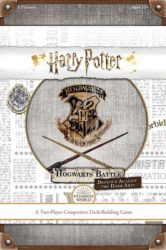 Harry Potter is a cultural phenomenon.
Harry Potter is a cultural phenomenon.
Even though J.K. Rowling only introduced the world to Harry Potter in 1997, he’s such a part of our collective consciousness, it’s hard to imagine a world without him.
And if you’re familiar with our board game reviews, you’ll also know we’ve reviewed 5 Harry Potter family board games in the last few years.
One such board game we love is Harry Potter: Hogwarts Battle by The OP (formerly USAopoly).
It’s a cooperative board game where players work together as Harry and his friends to defeat their villains. And the central method of play is deck building — where players start with a basic personal deck of cards and improve it as the game progresses to get more powerful.
Today we’re excited to review a similar but separate game, Harry Potter: Hogwarts Battle – Defence Against the Dark Arts.
It’s a bit strange of a game title because it’s not an expansion to the original cooperative game. Instead, it’s a standalone game for 2 players.
Rather than working together, 2 players go head-to-head in a dueling battle!
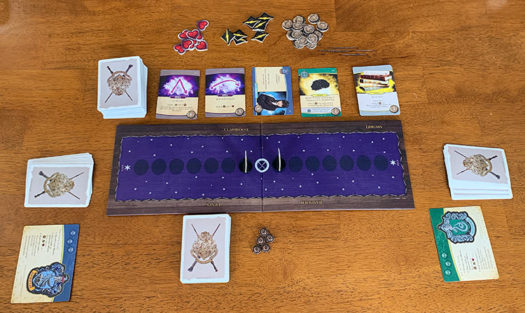
How to play Harry Potter: Hogwarts Battle – Defence Against the Dark Arts
If you’re familiar with the cooperative board game Harry Potter: Hogwarts Battle, you’ll be able to jump into Harry Potter: Hogwarts Battle – Defence Against the Dark Arts without any problem.
Like the original game, each player will start with a personal deck of 10 cards and will purchase more cards to add to their deck to become more powerful.
But rather than casting spells on villains, you’ll cast them at each other!
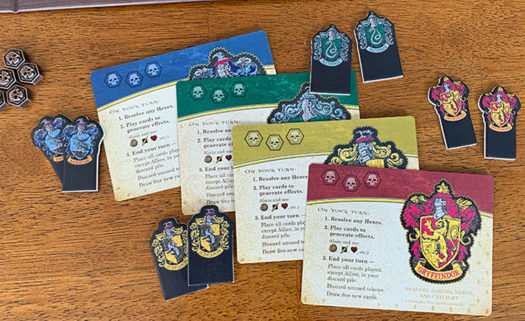
It’s really a simplified version of the game and it really feels like you’re practicing your spell casting.
Players begin by selecting a House to be associated with and also selecting a starting Ally (between Owl, Cat, or Toad). They also get their starting deck of cards and place their player piece on their side near the center of the board.
The House cards are double-sided on alternating cards and there are 2 playing pieces of each House so players may choose the same House. They can also choose the same Starting Ally.
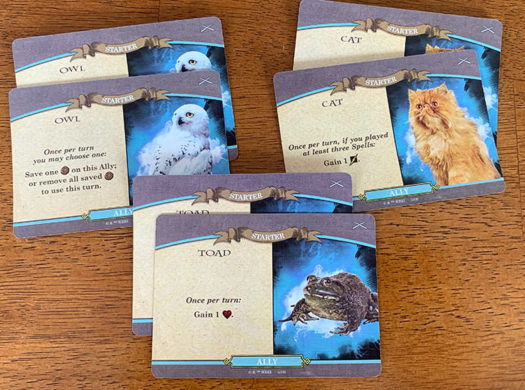
Players shuffle the Hogwarts card deck and place 4 cards face up near the board where it says Classroom. These are cards available for purchase and show their cost in the bottom left corner. There is also a deck of Book cards that are placed next to the Library and a deck of Hex cards that are shuffled and placed on the other side of the board.
The House cards each player has outlines what a player does on their turn.
Players begin a turn with 5 cards in their Hand. If there are any Hexes in their hand, the player must first resolve them.
Next, the active player plays their Hogwarts cards to generate different effects. These cards consist of Spells, Items, and Allies. The effects consist of gaining Lightning, Heart, or Money tokens. The cards are played face up and the player gains the tokens shown.
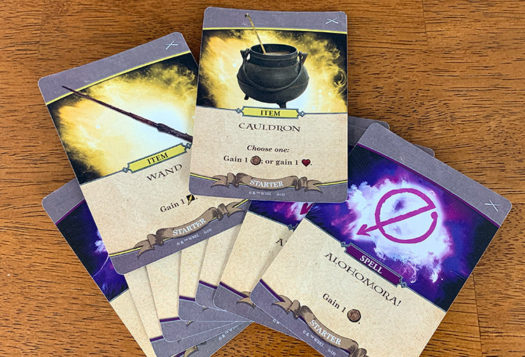
When a player plays an Ally card, they place it in front of them and will get help from that Ally on an ongoing basis. All other cards will be discarded at the end of their turn.
Then the player uses the tokens they’ve gained.
- Lightning: each Lighting token is a hit against their opponent and pushes them backward one space on the dueling table.
- Heart: each Heart token lets the player recover by moving toward the center one space on the dueling table.
- Money: the player uses their money to purchase Hogwarts cards from the Classroom or Library. Once purchased, the new card is added to the player’s discard pile.
All cards (except Ally cards played) are placed in the player’s discard pile. They also discard any unspent/excess tokens. The player then draws 5 cards from their deck to their Hand. If they run out of cards, they shuffle their discard pile and continuing drawing to 5.
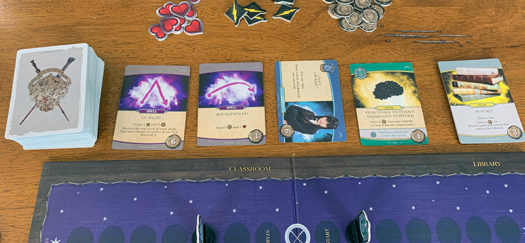
Then it’s the next player’s turn.
Once a player’s piece is pushed back to the Stun space on the dueling table, that player takes a Stun token and places it on their House card.
This ends that dueling round and players reset for another battle.
Each player shuffles all their cards (including Ally cards) to create a fresh deck and draws 5 cards to begin again. Both players move their playing piece back to the center and the player who was stunned chooses who goes first.
Once a player has been stunned 3 times, the game ends. Thus, the first player to stun their opponent 3 times wins the game!
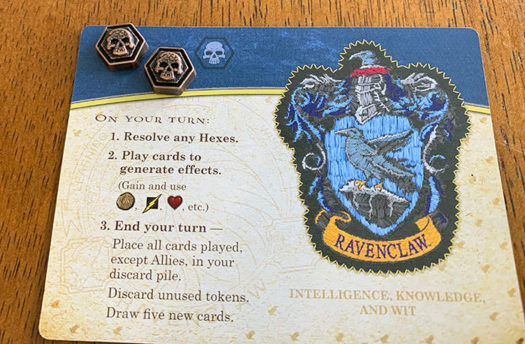
Can the whole family enjoy Harry Potter: Hogwarts Battle – Defence Against the Dark Arts?
Harry Potter: Hogwarts Battle – Defence Against the Dark Arts is a fun family game for those who love Harry Potter.
It totally creates a feeling of dueling each other depicted in Harry Potter and the Chamber of Secrets.
The recommended age for the game is 11+, but we know younger players will enjoy playing as well. As long as players can read the cards themselves, they should be well equipped to play.
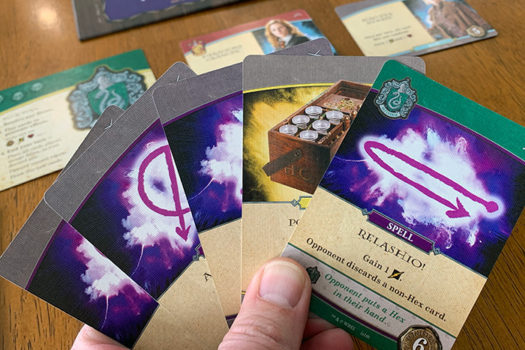
We really enjoy the original game Harry Potter: Hogwarts Battle because we like cooperative games. And as you progress through the different books and fight tougher opponents, the tension builds to a fun crescendo. (Even if we have a hard time winning in later chapters.)
And we’ve found that Harry Potter: Hogwarts Battle – Defence Against the Dark Arts also has a nice build-up to it. The game starts slowing as players start building their personal decks based on which cards show up in the Classroom.
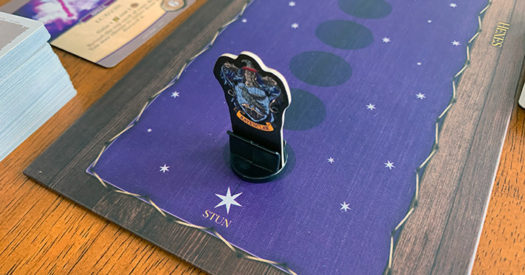
Once the first player gets stunned and both players reshuffle all their cards to create a fresh deck, the game feels like it starts to hit its stride. Because now players have a more robust set of cards to work with.
But we find the game really comes alive in the 3 battle and beyond. (That is if it goes beyond 3 battles and one player hasn’t completely dominated.)
Most times our games have gone beyond 3 battles. But there still is the potential of “the rich getting richer” syndrome. Depending on which cards are in the Classroom, one player may have more opportunities to get powerful cards that their opponent won’t have.
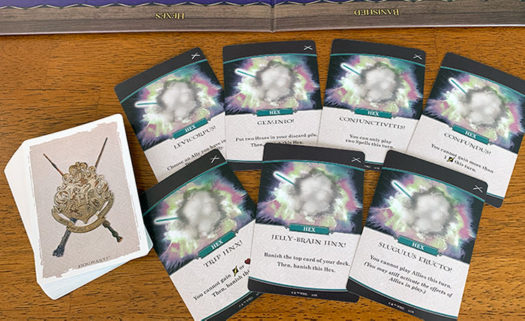
Yet, we love that randomness!
We love that each of our decks will be different!
Even though one player may get a few great cards, how each game plays out depends on when the cards come into hand.
And that means there’s always a chance to win!
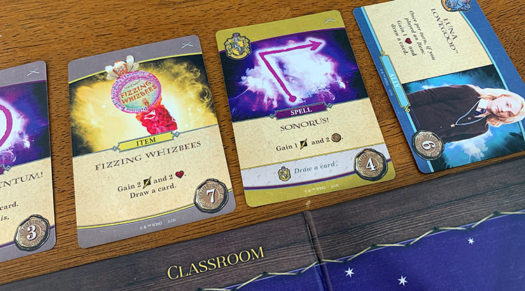
Understanding that randomness and planning accordingly creates a fun tension to the battles.
Another element we really enjoy is the way some cards get bonus abilities. There are some Hogwarts cards that are colored to match the 4 Hogwarts Houses. When a player has a cards in hand that matches either their House card or an Ally they have in play, they get to use the standard effect on the card as well as the bonus effect listed at the bottom of the card!
This adds another cool element to choosing which cards to purchase on your turns. Players that can stack matching cards like this will feel their power surging as they gain an upper hand in the duel.
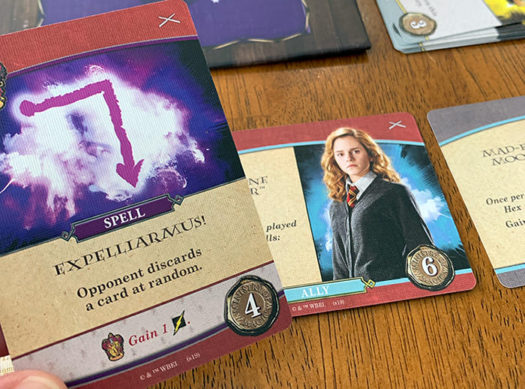
The game comes with plenty of tokens, but depending on the age of the player, you may not need to use them at all. We find they’re good to use when teaching the game (no matter the age of the player). But as soon as players get a sense for the flow of play, they’ll be pushing their opponent back and healing themselves without grabbing tokens first.
Overall, Harry Potter: Hogwarts Battle – Defence Against the Dark Arts is a terrific 2-player game. The theme is fun and the game play fits the theme very well.
Our only complaint
As much as we love the game, there is one thing that really bugs us.
The dueling table color design is terrible!
The shape of the board is great. The long nature of the board creates an environment just like the dueling table in the movie.
But the individual spaces on the board are tough to distinguish because they don’t contrast enough with the table itself!
They’re just darker ovals.
If you’re looking directly from above, you can see the spaces okay. But when sitting at the table (as players tend to do when playing a game), the spaces are almost indistinguishable from the background.
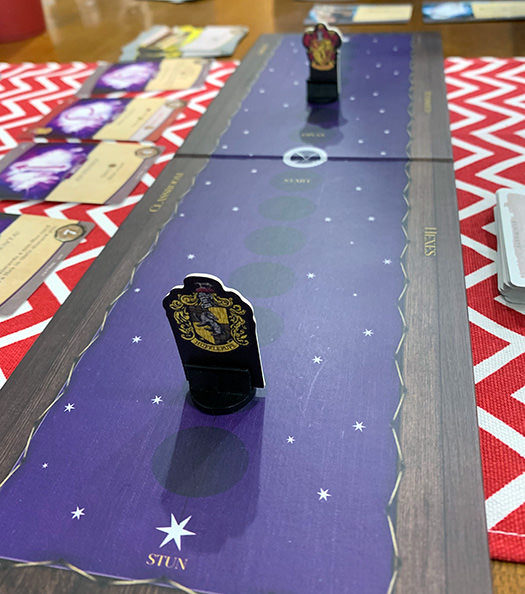
As the whole game revolves around moving forward and backward from space to space on every player’s turn, this issue really stinks.
Taking a look at photos of the dueling table from the movie, you can see there are crescent shapes that look like spaces. We sure wish The OP would have added those to the board design.
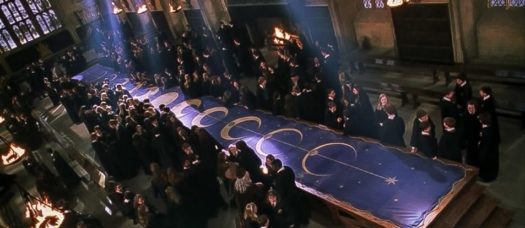
So what to do?
Our plan is to grab some oval stickers or draw on the board with a white marker so that we can more easily distinguish the individual spaces on the board.
How does Harry Potter: Hogwarts Battle – Defence Against the Dark Arts score on our “Let’s Play Again” game meter?
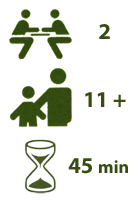 Harry Potter: Hogwarts Battle – Defence Against the Dark Arts scores very high on our “let’s play again” for many reasons.
Harry Potter: Hogwarts Battle – Defence Against the Dark Arts scores very high on our “let’s play again” for many reasons.
First of all, we love the theme.
Secondly, we love the deck-building nature of the game.
And we love the randomness that comes from the huge deck of Hogwarts cards. In each game we barely scratch the surface of cards showing up in the Classroom to add to our decks. There’s a ton of replay value in the amount of cards included in the game and how many come up each game.
We also love that it’s a cool 2-player game. Because with dwindling members of our family at home, we find we’re currently playing a lot of games as 2 players.
If you haven’t guessed yet, we highly recommend Harry Potter: Hogwarts Battle – Defence Against the Dark Arts as a fun 2-player game for families.
P.S. Is it fair to warn you that we also have another Harry Potter game in the queue for a review coming soon?
We’d like to thank The OP for a review copy of Harry Potter: Hogwarts Battle – Defence Against the Dark Arts.



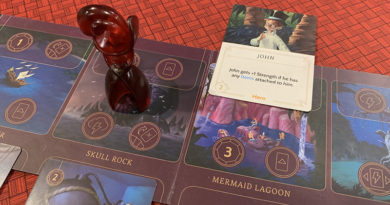
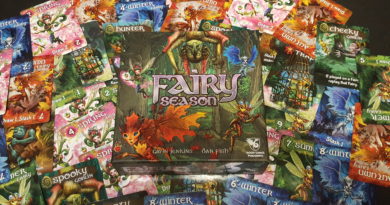
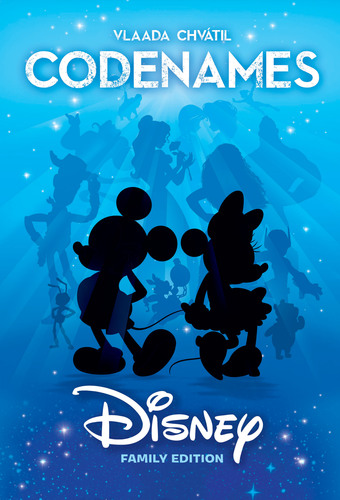
Hi 🙂
We have the German version of the game but unfortunately the translation of the Revelio Card is so misunderstanding, that I was wondering if you could tell me, what the card says in the English version?
Thanks so much!!
All the best from Austria!
Jana
Jana – In the English version, the Revelio card says “Reveal the top card of your deck. If it has a value of 4 (Influence – coin icon) or more, draw that card. Otherwise, gain 2 (Influence – coin icon).”